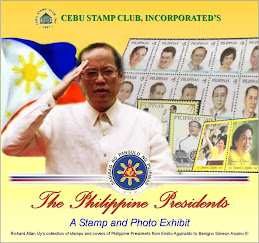On March 16, 2012, the Philippine Postal Corporation (Philpost) comes out with a commemorative block of 4 stamp highlighting the 75th anniversary of the City of Davao.
The 4 stamps were designed by the Davao City 75th Anniversary Committee with the photos provided by the City Tourism Office of Davao. The lay-out was by Victorino Z. Serevo with Atty. Lyka Lopez and Jason Magnaye as design coordinators. Amstar Company, Inc. printed the stamps.
Stamp # 1 shows the façade of the City Hall with the anniversary logo;
Stamp # 2 highlights the Kadayawan Festival, the King of all Festivals known to Davaoenos. Kadayawan is derived from the Mandaya word “madayaw”, a warm and friendly greeting used to explain a thing that is valuable, beautiful, superior, good or profitable. In 1988, it was renamed as “Kadayawan sa Davao”. The festival honors the city’s richness, diverse artistic, cultural and historical heritage in a grand celebration of thanksgiving for all of Davao City’s blessings.
Stamp # 3 features Davao City's famous Waling-waling orchid. It is described as the “Queen of the Philippine Orchids”. It is one of the largest species in the world and was discovered in Davao at around 1880 by Carl Roebellin, a German Plant explorer. It was named Vanda Sanderiana in 1882 by German Orchid taxonomist Heinrich Gustav Reichenbach and grows on tree trunks in the rainforests of Davao, Sultan Kudarat and other parts of Mindanao. The Waling-waling blooms only once a year, between July and October.
Stamp # 4 showcases Mt. Apo, the Philippines’ highest mountain and home or nestling ground of the Philippine Eagle (Pithecophaga jefferyi). Mt. Apo is a volcanic mountain that is located between the provinces of Davao del Sur and North Cotabato in Mindanao, Philippines. It is the country’s highest peak towering at 10,311 feet and the grandfather of all the Philippine mountains. On the other hand, the Philippine Eagle is n eagle of the family Accipitridae that is endemic to the forests in the Philippines. It is among the rarest and most powerful birds in the world. It has been declared the National Bird of the Philippines.
Davao's history was recorded as early as 1848. Davao used to be known as Nueva Vergara, a distinct geopolitical entity during the last 50 years of Spanish rule in the country.
In 1868, what used to be known as Nueva Vergara became Davao, a name derived from its Bagobo origins. The Tagabawa called the river "Dabo", the Giangan or Diangan who called it “Dawaw”, and the Obo called it “Davah”.
During the year 1868, the Spaniards became successful in the systematic and concerted effort in winning over the native inhabitants to the folds of Christian life. Three Jesuits missionaries who arrived in Davao to take over the mission from the lone Recollect priest in the Gulf area started this cause.
In the earlier years of American rule which was in December 1898, the town became the new growth center of the Philippines. The American settlers immediately recognized Davao’s rich potential for agricultural investment. Davao soon became one of the major producers of export products such as abaca, copra, and lumber in the first two decades of the 20th century. Inter-island vessels made the whole province a regular port of call in addition to the rise in numerous stores and business establishments. Davao's population rose rapidly and became a key contributor to the country's economy and foreign trade.
On October 16, 1936, by virtue of Commonwealth Act No. 51, popularly known as the Charter of the City of Davao, the Municipality of Davao became a city under the sponsorship of Assemblyman Romualdo C. Quimpo. On March 1, 1937, the city was officially inaugurated with the presence of Elpidio Quirino, the Secretary of Interior who was President Manuel L. Quezon's representative.
During World War II, Davao City was greatly devastated with the most number of lives lost compared to any city in the country. Gradually, Davao regained its status as the main agricultural and the trade center of Mindanao. Logs, lumber, plywood, copra and banana products replaced abaca as the major export products. The City of Davao came to be known as “the Melting Pot of the Philippines”. Davao aims to be the new Gateway of the Philippines.





















WELCOME FROM PAKISTAN
ReplyDelete